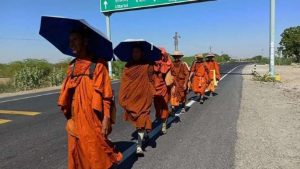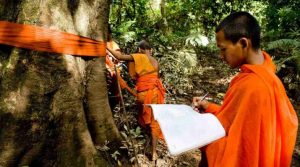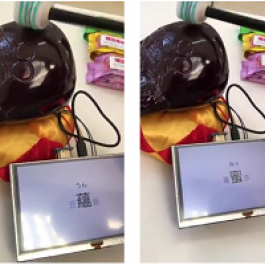Rarely does a story about another person contain so much heart. After reading Dipa Ma, you feel you have actually met her – and you will never forget her.
– Paul Hawken, co-author of Natural Capitalism
It was in India, years ago, that I heard her name: “Dipa Ma.” I had no idea who she was, but even the name sounded motherly. Apparently, she was a prominent female Buddhist master in Asia and around the world, but I was still studying and didn’t have time to learn more about her.
As karma would have it, just some weeks ago I picked up a book in the library of Wang Fat Ching She temple. It was by Amy Schmidt and titled, Dipa Ma – The Life and Legacy of a Buddhist Master. I read it several times and also revisited an interview with Dipa Ma called “Enlightenment in this lifetime: Meetings with a remarkable woman” was published by Tricycle in 2004. The interview was hosted by Jack Engler and took place in Calcutta in 1977. Delving deeper, I phoned Venerable Shilananda, one of my masters in Bangladesh, and asked about Dipa Ma. I was astonished when he told me that she was born in my neighboring village, Padua, in Chittagong. I never met this woman and she has long gone. But her proximity to my home and heart led me to feel that I actually met her, and that I will never forget her.
Dipa Ma was born in 1911and passed away in1989. She was a meditation master with profound wisdom and compassion. While she was not a “celebrity Buddhist” in the mold of Ajahn Brahm or Thich Nhat Hanh, she was surprisingly influential. Joseph Goldstein and Jack Engler were both deeply motivated by Dipa Ma and her teacher Anagarik Munindra, another meditation master from Bangladesh. To develop Buddhist spirituality in the West, they invited Dipa Ma to the United States in1980 and 1984. She made two trips to the West, both to teach and to learn. Her meditation retreats were immersion courses in which people developed their capacity to find stillness of mind and greater awareness.She was also a teacher of Joseph Goldstein, Sylvia Boorstein, Jack Kornfield, Michelle Levey, and Sharon Salzberg – now all household names in Western Buddhism.
Daniel Boutemy, a Western student of Dipa Ma, shared his experience as follows: “Whenever I came to Dipa Ma with some difficulty in my meditation practice, she would look into my eyes with the tranquil, Samadhi-like gaze while I was speaking…I believe she was capable of psychic or telepathic linking, working directly with others’ minds. She taught me silently that the answer to any internal problem was in the basic mind state and not in her words or in my technical adjustment of attention. She gave me the answer to my difficulties by sharing another state of consciousness in which that problem simply didn’t exist. It was a sudden, instant shift, like a psychic chiropractic adjustment.”
A Tragic Background
Dipa Ma’s full name is Nani Bala Barua, but was affectionately called “Dipa’s Mother” because she had a daughter named Dipa. Dipa Ma (Nani Bala Barua) was born in Chittagong of Bangladesh where Buddhists claim to enjoy a lineage all the way back to the Buddha. But after the Pala Dynasty, Buddhism in Bengal experienced an enormous decline throughout Islamic times. Meditation practices were almost wiped out of existence, leaving behind only rituals and rites. However, Buddhists in Arakan in Myanmar did not forget their heritage. Dipa Ma’s thinking was shaped by this consciousness of “endangerment” as well as by Myanmar’s culture and customs she experienced while living in Yangon.
Dipa Ma was married at the age of twelve and after two years left for Yangon with her husband. She gave birth to three children but her happiness was short-lived. She not only outlived her parents but also her husband and two of her children. Only her daughter, Dipa survived. The heartbreaking sudden loss of her loved ones crippled and paralyzed her emotionally. To make matters worse, she was diagnosed with high blood pressure, to the stage where doctors expected her to die at any time. Aware of her imminent death, she decided to move to a meditation center. Though she knew nothing about practice, she started to meditate. She learnt basic instructions on mindfulness and realized the Buddha’s teaching of impermanence. Gradually, her fear of death subsided and her health miraculously improved.
She began practicing at home and learned from Anagarik Munandraji, who at the time lived at a nearby monastery. Munandraji encouraged her to come to Thathana Yeiktha, the meditation center where the eminent Venerable Mahasi Sayadaw taught. After studying under Mahasi Sayadaw’s guidance, she felt she had truly transformed herself. No longer did she feel the sorrow that had constricted her heart for so long. Through the classical phases of insight meditation, she experienced a brilliant light. In an interview she said, “Once, with Munindraji’s guidance, I made the resolution to enter and remain in the eighth jhana for three days, eight hours, three minutes, and twenty seconds. That’s just what happened. But jhana practice doesn’t end suffering.”
In 1966, her teacher Munandraji left for India while she became an instructor in meditation. Her first formal student was a woman called Malati Barua. This was the beginning of Dipa Ma’s long career of teaching householders, especially women.
While living in Myanmar in 1967, Dipa Ma faced enormous problems when the government ordered the expulsion of foreigners. Although many were forced out of the country, she alone got an offer from some monks to remain there thanks to her meditation service. But out of concern for her daughter, she left for Calcutta in India. Shabby as it was, her abode in Calcutta’s shantytowns was where she practiced meditation and taught others. She single-mindedly devoted herself to helping other spiritual practitioners and experienced deep levels of meditative absorption. She did not make herself known outside her immediate circle of acquaintances, keeping a traditional instructional style yet always being available for those who wanted to receive meditation guidance.
Dipa Ma is an incredible example for modern laypeople who are committed to practicing meditation. She has also influenced the women’s movement within Buddhism, thanks to what was perhaps the only disagreement between her and her teacher Munandraji. Once, he was teaching some of Dipa Ma’s older female students about rebirth and claimed a woman must take birth in a male body to become a Buddha, but suddenly Dipa Ma exclaimed, “I can do anything a man can do!” Therefore, it seems right that American bhikkhuni Ajahn Thanasanti should have the last word:
“Coming from California, my personal image of a powerful woman was an amazon who jumps in the back of a pickup truck with a chainsaw and is going to short out the world. But the power of Dipa Ma was the power of touching the heart. I felt completely known by her. And yet I didn’t need to hide or be ashamed, because I felt both totally known and totally loved at the same time. I remember writing a letter home to my friends after experiencing that kind of love, telling them that if my journey had ended at that point, it would have been good enough. Just having made contact with that profound love was enough.”









